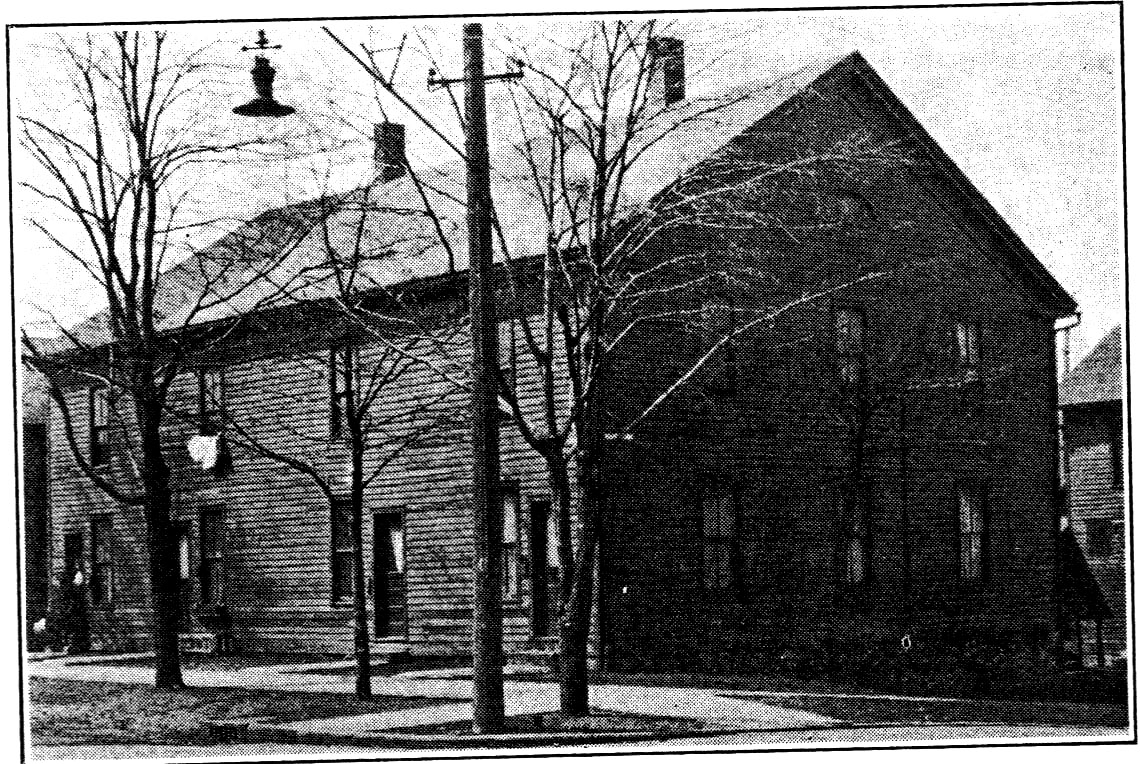

Our first church building erected in 1857 on the northwest
corner of Ionia Avenue and Weston Street.
This was our church home until 1868. The building was moved to the
southwest corner of Williams
Street and Finney Avenue, SW.
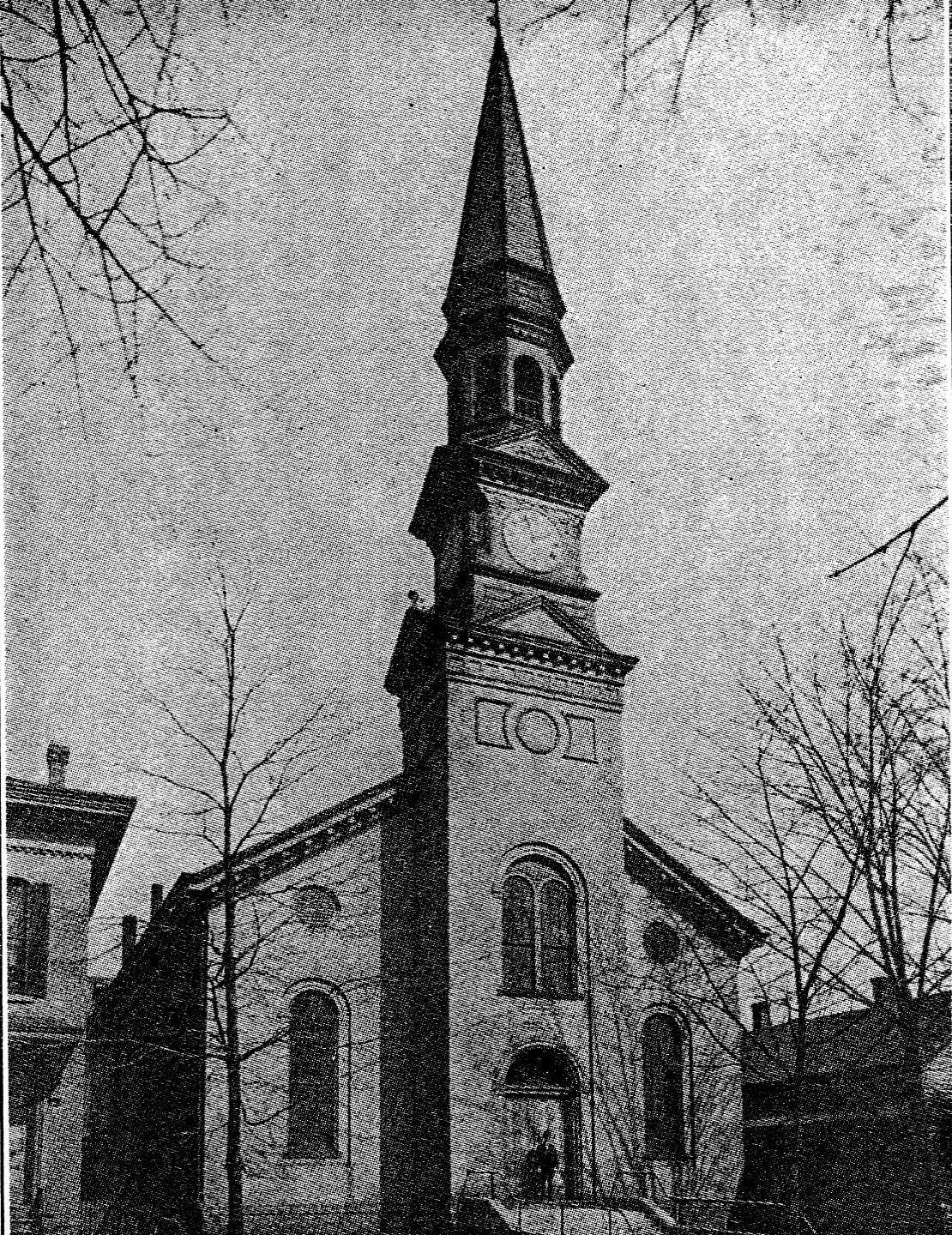
The church on Commerce Street, showing a section of the parsonage at the left.
This was our church home from 1868 to 1912.
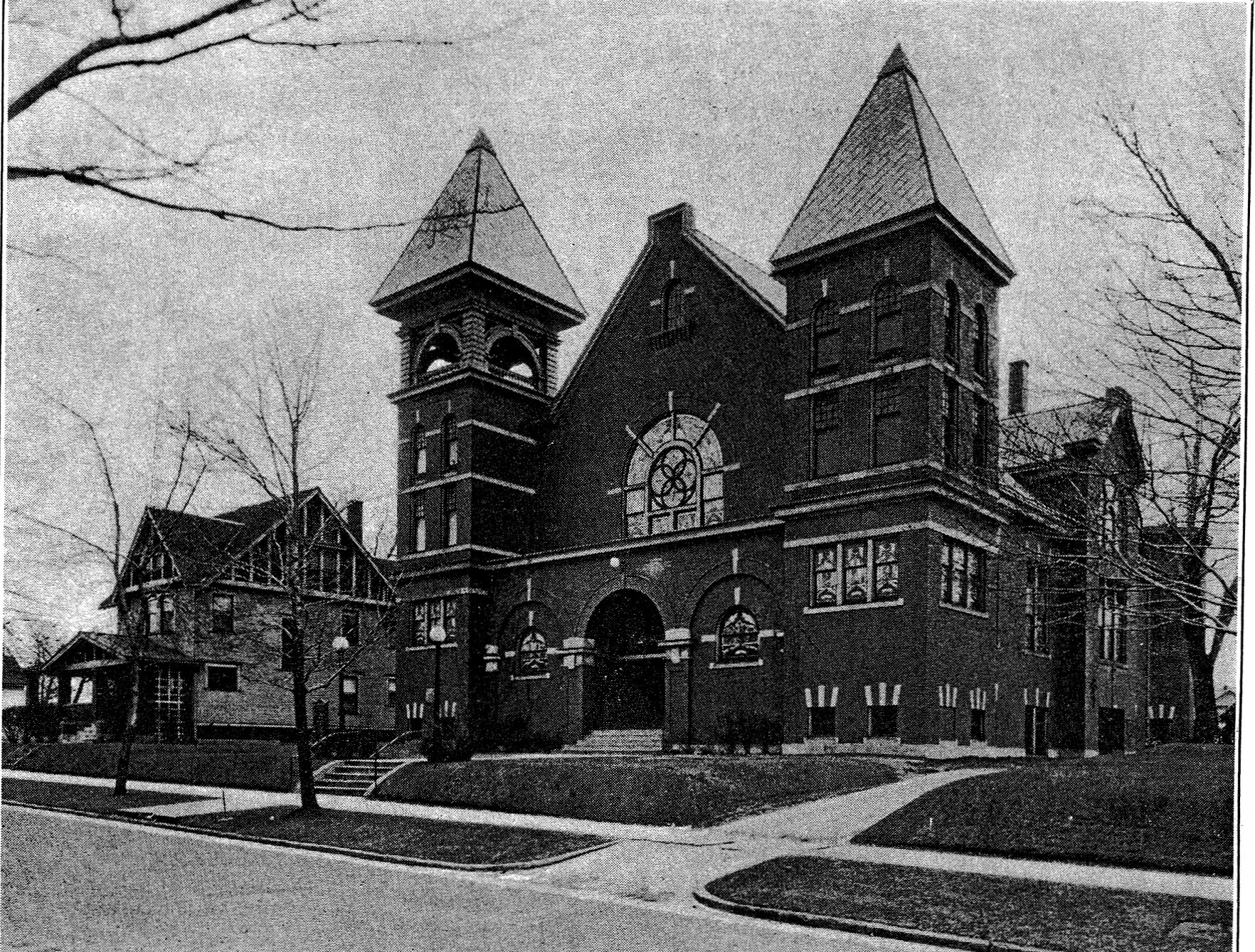
First (Bates Street) Christian Reformed Church
Grand Rapids, Michigan
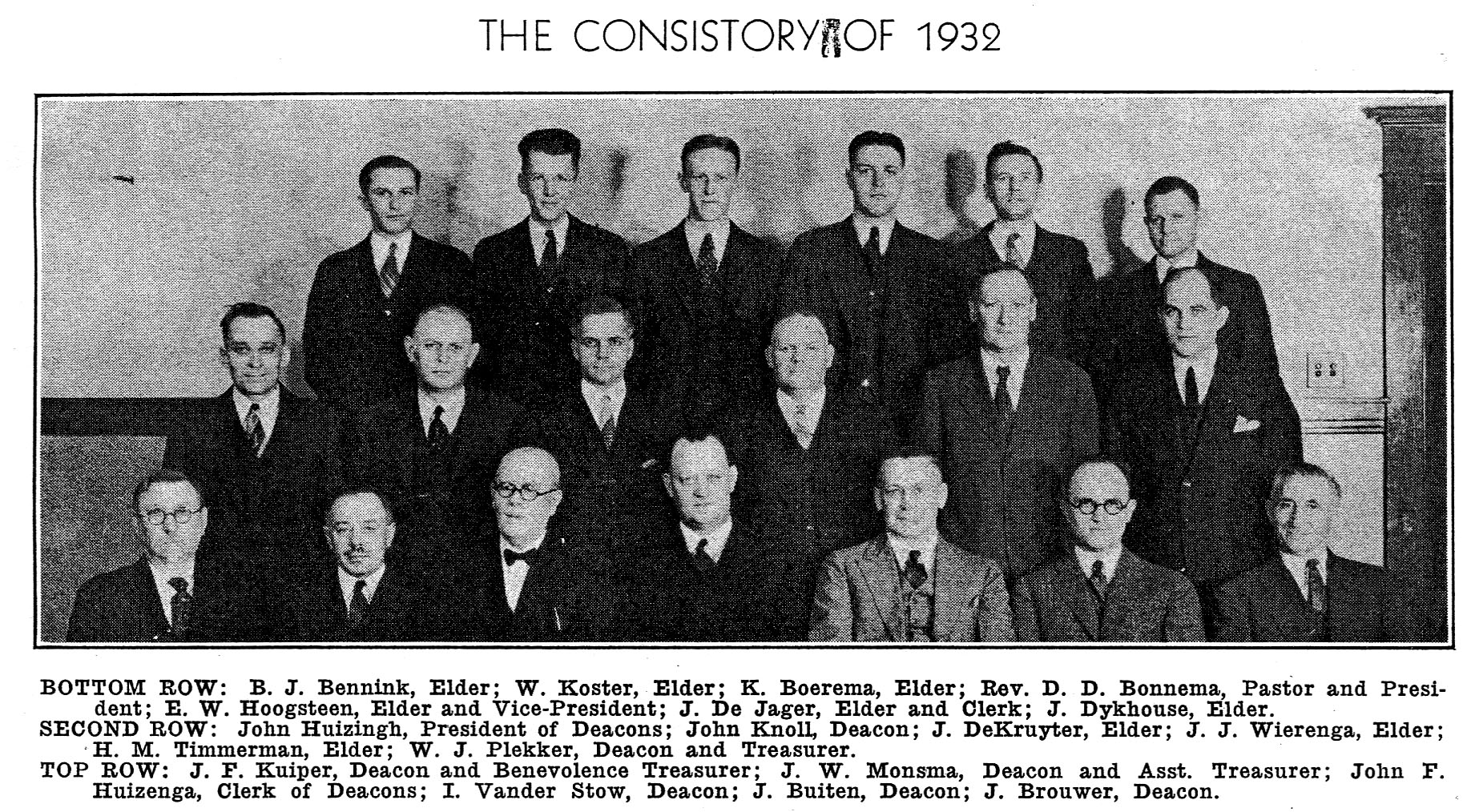
(Bates Street Christian Reformed Church)
While our church was formally organized on Mar. 19, 1857, the action which led directly to it was taken about a year before. At a consistory meeting held April 14, 1856, of the Second Dutch Reformed Church of Grand Rapids, resignations of membership were presented by the following: John Gelok, G. Grootveld, Gysbert Haan, P. Haan, E. G. J. Ham, and A. Van Hooven. The immediate occasion for such action seems to have been the decision reached at a meeting of Classis held at Zeeland on April 3rd that a Day of Prayer be set aside for a removal of the spirit of doubt as to the soundness of the Reformed Church, referred to by one of the attending ministers as a spirit of the devil. While that decision led to this drastic action, the conviction that union with the Reformed Church should never have taken place, had been growing steadily for several years. Our parent church, the Second Reformed (now Central Reformed, resulting from a merger with the First Reformed), had taken no part in the so-called Union with the Reformed Church which took place on June 4, 1849, inasmuch as it was not organized until July or August of that year, and was first represented in a Classis of these churches in October of that year. However, from time to time since immigrants arrived in Grand Rapids in 1848, Rev. A.C. Van Raalte of Holland and others would come to preach for them, and at their request he organized the congregation and installed the elders and deacons then chosen. By such action we became a part of that denomination. The founders of the Christian Reformed Church did not, however, simply sever their connection with one denomination and start another. They protested at consistory and classical meetings against conditions they believed to be wrong in their church until it was demonstrated to be futile, as is evidenced by the classical decision above referred to. While it would be interesting to follow the whole course of events in all the various communities, this is not the occasion for it, and we shall have to limit ourselves to Grand Rapids. Happily we have not been left in the dark as to why the brethren above mentioned left the Reformed Church. Thanks to the thoughtfulness of our second pastor, Rev. W.H. Van Leeuwen, we have a written record supplied by one of the first elders who served our church, namely, John Gelok. At the consistory meeting of October 28, 1864, the pastor suggested that something of the kind be written, and brother Gelok was asked to do so, as being more familiar with the history than anyone else. He presented it at the next meeting, on November 11th. It was approved, and then placed in the front of the first consistory minute book, dating from May 31, 1861. In this document, impurity in doctrine is emphasized, consisting of the spreading of tracts teaching a general atonement, the preaching of such doctrine from the pulpit, and especially the printing and continued circulation of a book, “Call to the Unconverted,” written by a Rev. Baxter, which was considered to be in flagrant contradiction of Reformed truth. It also mentions the admission of non-Reformed Christians to the Lord’s Supper in violation of Article 61 of the Church Order which had been adopted, and the introduction of hymns in violation of Article 69. Further, it mentions that ministers of other communions had been permitted to conduct services; that certain students for the ministry were in opposition to Reformed truth’ and also that the installation of an elder who was considered unsound in faith was insisted upon to keep the consistory in line with the Reformed Church. These I believe to be the essential points mentioned. At the session of Classis held in the spring of 1855 at Zeeland, our delegates inquired if the book, “Call to the Unconverted,” was in harmony with the Forms of Unity. At the fall meeting, our delegates were present with new objections and a protest against Rev. Van Raalte because he continued the circulation of this book. The Classis deemed it inadvisable to go into the matter at that time, probably in view of his absence at that meeting. At the next meeting, that held in the spring of 1856, our delegates again pressed for action on their protest. The result was that Classis decided to hold a Day of Prayer on April 10th, and such services were actually held. This is the decision referred to as being the immediate occasion for severing connections with the Reformed Church. At said meeting, the suggestion was also offered that we separate instead of causing so much trouble. Between April 3rd, the date of that meeting and April 10th, two elders, Gysbert Haan and John Gelok, resigned. They also resigned as members of the church, in which they were joined by the four others as previously mentioned. This small group then began to hold services in a private home. Their action caused a great stir in the church they left inasmuch as a large number of its members were in hearty accord with the views of those who had departed. Discussion and agitation kept right on. Many of the members informed their pastor that they, too, felt they should leave. Especially the matter of the admission to the Lord’s Table of members of the Congregational Church with whom they were not even acquainted was cause for serious apprehension. On Sunday, Jan. 25, 1857, Rev. H.G. Klyn formally declared his secession from the Reformed Church. He justified his action for the following four reasons: first, the use of hymns in the Reformed Church; second, choir singing in said church, third, Union Sunday School books used therein, which are not in harmony with the creed of the Reformed Church; fourth admission of all evangelical Christians to communion with them and of evangelical ministers of other denominations to their pulpits. Somehow it must have leaked out what he intended to do. At an early morning session, the consistory excluded him from the pulpit that day. As Rev. Klyn planned to occupy his pulpit, the way to it was barred by elder Francis Van Driele. It was a tense moment. Facing his people in front of the pulpit, Rev. Klyn threw up his arms up and cried, “Lord, I have sinned, but what have these sheep committed?” Then he walked out, followed by about half of the congregation, which at that time had approximately one hundred families. That same afternoon he preached in the home of Gysbert Haan, near the site of our present post office. Rv. Klyn immediately set to work to formally organize the congregation. He arranged for a congregational meeting, at which three elders and three deacons were elected. The date of this meeting, March 19, 1857, is considered the birthday of our church. On this occasion he preached a sermon on Acts 13:2,”And as they ministered to the Lord, and fasted, the Holy Spirit said, Separate me Barnabas and Saul for the work whereunto I have called them.” Our first elders were John Gelok, John Gezon, and Gysbert Haan; our first deacons: Berend De Graaf, Henry Moerman, and Adrian Pleune. Secession was in the air also in other places. At the meeting of Classis Holland of the Reformed Church held at Holland on April 8, 1857, formal notices of withdrawal were presented by the consistories of Graafshap, Noordeloos, and Polkton, and from the Revs. H.G. Klyn and K. Vanden Bosch, pastor of the Noordeloos church. These were received and filed by Classis, with no further action being taken. This date, April 8th, is usually regarded the birthday of our Christian Reformed denomination. The seceding churches effected a classical organization, holding their first meeting during the latter part of April. Our pastor, Rev. Klyn, was President of this Classis, and Rev. Vanden Bosch, Clerk. It is too bad that the date of this meeting cannot be established. The minutes are lost. They would be of great value in settling the question of the date of the beginning of our denominational existence. We now were a formally organized church. The number attending our services was such that continuing to meet in a private home was out of the question. We also needed a home for our Christian School which had held its session in the Second Reformed Church. This school was started in the winter of 1855-56. At first, school was held in a house, back of the church, on Bostwick Street, and later on, in the church itself. Its first teacher was Adrian Pleune, one of our first three deacons. Arrangements were made to hold services Sunday morning and afternoon in Collins Hall on old Canal Street (now lower Monroe Avenue) and in the evening in Faneuil Hall, the second story of Gunn’s Hardware Store in the southwest corner of Monroe Avenue and Market Street where the Widdicomb Building now stands. With willing hands and hearts, the congregation set to work to have a church of their own. That same year, 1857, one was built on the northwest corner of Ionia Avenue and Weston (formerly Island) Street. Opinion differs as to whether the real estate and building together cost $3,000 or $4,000 and there is no record available to prove either contention. The Christian School held its sessions in a room at the rear of the church. This building is still in existence, having been remodeled for residence purposes, and is now located on the southwest corner of Williams Street and Finney Avenue. Sorry to say, we had internal troubles at an early date in our congregational existence. After serving the congregation for only half a year, Rev. Klyn left our church and denomination and returned to the Reformed Church. Not long thereafter one of our first three elders, John Gezon, resigned his office. In 1861 we had a good deal of trouble with another of our first three elders, Gylbert Haan, who had been so active in the movement to server connections with the Reformed Church. He seems to have inclined to the idea that the eldership was an office for life. He refused to submit to re-election. The matter was brought to Classis and it was of the opinion he should be permitted to continue to serve on the basis of the doctrine of “the profit of the church” but this cause dissension in the congregation, the final outcome of which was that brother Haan left for the Reformed Church. Later on, however, he came back to our church. When Rev. Klyn left, the only Christian Reformed minister was Rev. K. Vanden Bosch, pastor of the church at Noordeloos. He became our “Consulent” or as we would refer to him today, our “Moderator.” Occasionally he would conduct services for us, but our elders were called upon to conduct reading services many a time. We were without a pastor from the fall of 1857 until July, 1863. During this vacancy, a Candidate Tubergen served us for about half a year. For a new pastor, we looked across the ocean to the Netherlands. Two of them declined our call. After extending four calls to him, Rev. W.H. Van Leeuwen finally accepted. On July 5, 1863, a special service was held in our church, thanking God for his safe arrival among us. The following Sunday he was installed as our pastor. He served our congregation well, and not only our congregation, but also our denomination, for on Nov. 14, 1864, he became the first Professor of what we now know as our Calvin College and Seminary. The parsonage was made to serve also as a schoolroom. To him was also delegated the supervision over our Christian School That he applied himself with energy is apparent from consistory minutes; also that he had some unpleasant experiences, such as for instance being compelled to retract a statement to the effect that the Pope was not the Anti-Christ. He remained our pastor until Feb. 10, 1867, when he preached his farewell sermon, having accepted a call to the First Christian Reformed Church of Paterson, N.J. This time we did not have to wait long for a minister. On June 18th of that year, our third pastor, Rev. R. Duiker, arrived in Grand Rapids, from Niezijl, Netherlands. Mr. Jacob Noordwier, now our oldest living Christian Reformed minister, and a member of our church, came along with him. He had already studies under Rev. Duiker for eleven years, and was permitted to continue and conclude his studies under him. On Feb. 17, 1869, he was admitted to the ministry. Not long after he arrived. Rev. Duiker had the pleasant task of laying the first stone of our church building on Commerce Street, construction of which was started August 23, 1867. This stone may still be seen in the main corridor in the basement of our present church building. A new building had become necessary because the old one could no longer hold the people who attended our services. The new church was dedicated on Sunday, May 17, 1868. The pastor was absent that day, having a preaching engagement in Grand Haven. Student Noordewier preached at all three services. His dedicatory sermon was base on Haggai 2:9: “The glory of this latter house shall be greater than of the former, saith the Lord of hosts: and in this place will I give peace, saith the Lord of hosts.” This certainly proved to be true in the history of our church. The initial cost of the building was about $7,000. A very interesting record in connection with the erection of this building is the subscription list for the purchase of bricks in the new church by various members. From time to time additions were made such as the substitution of a furnace for stoves, the building of the two side galleries, and finally in 1888, the building of the tower and spire. It is unfortunate that at least for a time the back gallery was left unprotected by a railing, as not long after the church was built a little five or six year old girl, Jennie Otte, fell off from it while playing. This broke her neck, resulting in her death. So far as our records can establish it, this church building, exclusive of the real estate and organ, represented a final cost of about $13,500.00. Rev. Duiker remained our pastor until April, 1872, at which time he accepted a call to the Reformed Church at Danforth, Ill., a very small congregation. He declared he was firmly convinced the Lord wanted him to go there, and further stated he had no fault to find with either our consistory or congregation, but had been treated well. Elder John Gelok, the President of the consistory, then asked for permission to go to the Netherlands to visit his friends and also to study at first hand the possibility of making nominations of other ministers there, as well as to attend the Synod at Groningen. This request was granted, and ratified at a congregational meeting held April 25th. On this trip he was accompanied by the brethren B. De Graaf and J. De Jonge. At the consistory meeting of July 8th, a letter from them was read recommending five ministers. The first two calls extended as a result of these nominations were declined. On Christmas Day, 1872, we called Rev. G.E. Boer. At the consistory meeting of March 18, 1873, his letter was read declining our call. But the consistory was unwilling to accept his “No” as final. On April 7th, a second call was tendered, and this he accepted. For a time after he accepted it, his conscience seriously troubled him because he had done so, but when he set foot on American soil, all doubt in Grand Rapids with his family on Sept. 17th. During this same year, 1873, a new parsonage was built next door to the church on the north at a cost of about $3,400. Our former parsonage stood on the northeast corner of Williams St. and Commerce Ave. From the time he came, Rev. Boer was a real leader in both congregational and denominational affairs. He was fitted for it both by temperament and education. He was broad in his sympathies, and was seemingly an indefatigable worker. He was our pastor for less than three years, but a lot was crowded into them. In 1875, he was placed in charge of “De Wachter.” That same year he was asked to take charge of the instruction of the four students then in training for the ministry. The next year, 1876, he became our first full-time Professor. At a consistory meeting held Jan. 27the, our delegates to the Synod to be held in Chicago in February were instructed to use their influence to further his appointment as such, not because we would like to lose him as our pastor, but because of the great need for a full-time Professor. They were also told to offer $400.00 per annum as our congregational contribution for the salary of such professor PROVIDED THE SCHOOL WOULD BE ESTABLISH and MAINTAINED IN GRAND RAPIDS. At the Synod, Rev. Boer was elected, and our offer accepted. The second floor of our congregational Christian School on Williams Street, built in 1874-75, at a cost of $3,199.31 for the building, and $133.10 for the real estate, became our first Theological School. Two other important events took place during Rev. Boer’s ministry among us, namely, the organization of the first two of our six daughter churches. The first of these is Kelloggsville, organized on Feb. 10, 1875, to which fourteen families were transferred. The second is Jenison, organized on July 18thof that year. When we consider the hardships that these people willing underwent to attend our services on Sundays, even walking the whole nine miles to Grand Rapids over the kind of roads we then had, shame should cover the faces of folks who today offer trifling excuses for absence at Divine Worship. We again turned to the Netherlands for a successor to Prof. Boer. Twice we were disappointed. The third call was to Rev. J. Kremer, and he declined it. A second call was immediately tendered. This he accepted, becoming our pastor on June 4, 1877. There was internal dissension in the congregation during his ministry, which finally resulted in some folks leaving to organize the Netherlands Reformed Church on Turner Avenue. These people seemingly were dissatisfied with everything in the church-the preaching of the pastor and of Prof. Boer, the actions of the consistory, and of the Young Men’s Society. It was a program rendered at a meeting or possibly Annual Banquet of this society that seems to have brought matters to a head. When two brethren appeared before the consistory in March, 1878, protesting against what the boys had done, the pastor stated he had attended this program and had promptly informed the boys of his disapproval, the result being that before it was all over the three young men had made a public apology and promised never to do anything of the kind again. He stated that in his judgment the matter could therefore be regarded as settled. It was clear that what had taken place was a case of misunderstanding and not evil intent. The consistory was not wholly satisfied and therefore asked the young men to appear before it, which they did, making a confession and consenting that an announcement of it be made to the congregation. The matters of difference could not be adjusted to the satisfaction of the protestants, however, and a number of them left. On July 31, 1879, Rev. Kremer informed the consistory that he had accepted the call to the South Holland, Illinois, Reformed Church. On Sept. 15, 1879, our third daughter was organized, namely, Eastern Avenue. When new congregations are organized nowadays, it is quite the custom for the mother church to give the daughter a certain sum of money. Something different was done in the case of the Eastern Avenue Church. In 1876, we built a small church on the site of the present Eastern Avenue Church. When this congregation was formally organized, this property was taken over by the new church for the sum of approximately $1,900.00, which was repaid to our church in installments. During this same vacancy our fourth daughter church, Alpine Avenue, was organized, on May 25, 1881. To fill this vacancy, seven calls were extended, all to ministers in the Netherlands. The last one was to Rev. J.H. Vos, and he became our sixth pastor, being present for the first time at the consistory meeting of August 24, 1881. Rev. Vos was pastor of our church for a longer period of time than any other minister in our history, remaining such until late in 1900. During his ministry our church had the largest membership it has ever had. According to the denominational Yearbook of 1887, we had four hundred families and one thousand, eight hundred members. In 1882 we were twenty-five years old, but the event was not commemorated in any special way. While Rev. Vos was our pastor, our fifth and sixth daughter churches were organized. The first of these was the LaGrave Avenue church, which was organized Feb. 24, 1887. It was the language problem that gave birth to that church. Our Grand Rapids churches were beginning to lose some of our young people because they could no longer understand preaching in the Holland language. The movement for an English speaking congregation in Grand Rapids was broached as early as 1879. The question came up at several of our Synods. Finally, a meeting was held on Sept. 16, 1886, which decided to ask the four Christian Reformed consistories in Grand Rapids to announce a public meeting to consider the advisability of organizing an English speaking church. From two consistories no answers were received; the third said it would do as the consistory of our church did, and our consistory did not comply with the request. Those sponsoring the movement then sent a petition to Classis in November, asking for the appointment of a committee to assist them in paving the way for organizing of a congregation. The petition was granted, notwithstanding the strong opposition of a part of our consistory. One of the committee so appointed was Rev. P. Ekster, who later became our pastor. He was the secretary of the meeting at which the organization of the LaGrave Ave. church took place. Our sixth and last daughter church is that of Franklin Street, organized on Mar 8, 1887. For these folks, too, we had already built a small church during the summer of 1886. Another thing which should be mentioned as occurring during Rev. Vos’ ministry was the purchase and installation of the organ, which took place in 1887. Together with installation expense, the instrument cost about $1800.00. It was dedicated on July 1st of that year. It served us until we purchased our present instrument a few years ago. Mr. Gerritt Winsemius, who died but recently, was engaged as our first organist, at a salary of $1.00 per Sunday for playing three services. He remained our organist until September 21, 1914. On Aug. 2, 1900, Rev. Vos asked the consistory to become an emeritus minister. At that time he was 74 years old. The consistory approved of his request, recommended it to Classis which granted it, and asked him to continue to serve as pastor until we had another minister. He preached his farewell sermon either the last Sunday in October or the first Sunday in November. Our vacancy at that time was of short duration. We first extended a call to Rev. Peter Ekster. He did become our pastor extended to and accepted by Rev. T. Vander Ark, who preached his inaugural the first Sunday in December, 1900. “Cast thy bread upon the waters, for thou shalt find it after many days,” says the author of Ecclesiastes (11:1). That was true as applied to Rev. Vander Ark, for he was the first pastor of our church who had been trained in our own denominational seminary, graduating in 1897. He had, therefore, been in the ministry but three years when he became our pastor. He remained such until March 26, 1905, when he preached his farewell sermon. During the year 1905, we discontinued our congregational Christian School on Williams St. By that time there were six other Christian schools in different sections of the city, and the central location of our school made it very difficult for children to attend. The consistory minutes of Sept. 12th show that we had but 13 pupils. So on Oct. 18th, it was decided to announce the next Sunday that the school would be closed. The school property was sold to the Salvation Army on Sep. 23, 1907, for $5,500.00. After using it for 30 years, we sold it at a profit of about $2,000.00. Today our boys and girls with comparatively few exceptions are attending the Baxter and Oakdale Christian Schools. During the vacancy that followed Rev. Vander Ark’s departure six calls were extended and declined, three of them to ministers in the Netherlands. The seventh was tendered to Rev. G.J. Haan, then at Zeeland. He accepted it, and preached his inaugural on April 1, 1906. On April 18th he informed the consistory that it was impossible for his family to live in the parsonage. This was not because the house wasn’t habitable, but because of the immoral conditions which obtained in the neighborhood. The consistory very properly decided we should have a new one. A congregational meeting was called for April 30th to consider the matter. A total of thirteen locations had been investigated, and the recommendation was to buy the one at 251 Sheldon Avenue (now 429-between Wealthy and Logan, on the west side of the street). This was adopted, and the house bought for $5,600.00, and the house bought for $5,600. It was in the year 1906 that the question of changing the location of the church came into active discussion. The matter was up for serious consideration by the consistory on Nov.12th. What brought it to a head was the condition of the roof of the church, which was leaking. A new one would cost a lot of money. Frequently the statement was made that if the congregation was to have a future it had to move. Two weeks later the pastor was asked to prepare an impartial statement of the situation, which, after being approved by the consistory, would be read to the annual congregational meeting to be held on Nov. 29th. At that meeting the congregation decided to seriously consider the situation and to hold another meeting on Dec. 13th. In the meantime, the consistory was very busy. On Dec. 3rd, it decided to send a mimeographed statement to all those entitled to vote at congregational meetings, and to adult baptized members, stating the situation, and enclosing a blank asking three questions: “FIRST, Do you think, a change of location is necessary; SECOND, Which proposed location do you think best; Lafayette Avenue, between Buckley (formerly Second and Fourth); Ionia St. near Franklin; and THIRD, Do you know of a better place? If so, where?” Replies were asked for by December 10th. Of such statements 168 were sent out, and 122 replies were received. Of these, 87 answered the first question in the affirmative, and 31 in the negative. As to location, 68 favored Lafayette Ave. Six other locations received a total 19 votes. That night, Dec. 10th, the consistory decided to recommend to the congregation at the meeting to be held on the 13th to definitely decide nothing unless three-fourths could agree on a new location. At the meeting on the 13th, the consistory was advised to get in touch with the Franklin Street, Oakdale Park, and Eastern Avenue consistories to see how they felt about it; to ask Classis for its advice; and in the meantime not to repair the roof, but if it got to leaking too badly, to call another congregational meeting. The consistory got in touch with the other churches at once. The Franklin St. consistory replied that our problem was a very difficult that it was too bad our church was declining, admitting it was necessary for us to increase our membership, but objecting to locating a new congregation on Grandville Ave. or at Ionia and Franklin. The Oakdale Park consistory said it would like to see us continue to exist and that would realized we simply had to change locations if such were to be the case, but that we should not proceed until we had reached a satisfactory understanding with the other consistories who might be involved, and finally that we should locate where the largest part of our membership lived and where it conflicted the least with other churches. The Eastern Ave. consistory likewise expressed the hope that our congregational existence would continue. It had no suggestions to offer as to location, but questioned that if we were to build in the vicinity of the Theological School, then located at Madison and Franklin, that very many of their people would leave to join us, and suggested that if we were in need of advice, to ask Classis for it. The consistory brought the matter to Classis also, and it appointed a committee which met with our consistory on March 25, 1907. At this meeting, it developed that there was a sharp difference of opinion among the members of our consistory. After hearing what all of the brethren had to say, the committee withdrew; and after deliberating upon the matter, informed the consistory that in its judgment a change in location was necessary but advised to proceed slowly because it felt the congregation was not ripe for the step. The consistory was divided equally. Half favored changing locations. The other half was opposed to it. Those who favored the step gave the following reasons: That the congregation could not continue to exist where the church was then located, and that this was admitted even by those were opposed to changing; that this was apparent because it was only strangers who kept up the attendance; that the congregational statistics showed a gradual loss; that the church was not located anywhere near where a large portion of its membership lived; that our young people were moving in a southeasterly direction, and that to keep them we had to move; that even there was talk of organizing a church in the vicinity of Union and Franklin and expressing the fear that we would lose many of our members unless we were the first; and finally, that finances should not be a stumbling block because the old property was to be was to be sold first, and this money used to build elsewhere. Those opposed gave the following reasons: That part of the congregation would not go along anyway; that attendance at services was very satisfactory, having in mind the location of the church; that regardless of where we might locate, we could not get a flourishing congregation; that the financial situation of the church was much better than it was for six or seven years before; that a centrally located Holland-speaking church was a necessity because many young people from the country worked or boarded in the vicinity; and finally, that because they could see no future for our congregation anywhere else, and having in mind God’s providential care through all the storms encountered to date, they did not have the courage to move. A very important congregational meeting was held on May 15th. The letters received from the three consistories above mentioned were read, as was also the advice of the Committee of Classis, and two statements containing the ideas of consistory members as above outlined. The consistory had previously agreed not to take any part in the discussion. At this meeting it was decided, before passing on the question of changing locations, that in the event we moved, it was only to be after the present property was sold. Then the question of changing locations was put before the meeting. The vote, taken by ballot, was: For changing, 62; against, 36. In view of certain requirements of State law, the proposal had to carry by a two-thirds vote to be adopted. Inasmuch as this was not the case, it was declared lost. It was then decided to fix up the roof. This decision, of course, was a bad blow for those who wished to change the location. But the matter did not end there. A new idea was submitted to the consistory at its meeting June 12th. Petitions signed by 39 members were presented strongly objecting to repairing the roof or spending any more money on the old church and suggesting instead to sell the property and start two new congregations, one on Grandville Avenue and the other in the vicinity of Union Avenue. The consistory met with a large group of these folks on July 2nd. It developed that some had signed the petition under misapprehension as to its contents. The consistory decided that because there was such a difference of opinion upon the whole subject of changing locations, it would do nothing further in the matter until at least two of those who had previously voted against changing locations gave evidence of a change of mind. It did not have to wait long. On July 24th, there were such declarations signed by three members. This resulted in the calling of another congregational meeting for August 13th. At this meeting it was moved and carried by a majority vote to reconsider the decision of May 15th. The question of changing locations was then put before the meeting. The vote was: For, 69; against, 38. Failing to carry by a two-thirds vote, the proposal was declared lost. This settled the issue for some time. During Rev. Haan’s ministry, we celebrated the 50th anniversary of our existence. On Sunday evening, March 31, 1907, the pastor preached an appropriate sermon, and special programs were given on Tuesday and Wednesday evenings, April 2nd and 3rd. The historical address on this occasion, which was published in souvenir booklet form, was made by Elder J.B. Hulst, then the Clerk of our consistory. Rev. Haan remained our pastor until January 19, 1908, at which time he preached his farewell sermon, having accepted a call from the First Church at Englewood, Chicago. When Rev. Haan left, Rev. Ekster was then called for a second time, on Jan. 9, 1908. Again he declined. The next call was extended to Rev. K. Van Goor, but he immediately returned it without consideration because of ill health. There was in the congregation at that time a determined effort to try calling Rev. Ekster once more. At the consistory meeting of May 13th a petition to that effect was presented by 52 members of the congregation. The consistory asked for and obtained permission to do so from Classis. On June 8th, Rev. Ekster was called by a unanimous vote and he accepted it. Serious illness, however, prevented his taking up his new duties for some time. On Sept. 27th, he was installed as our pastor. It was in that same month of September, 1908, on the 8th, that it was decided at a congregational meeting to dispense with the afternoon service. Not very long after Rev. Ekster came, the matter of changing locations came up again. This time the question was brought up somewhat differently, namely, by deciding to offer the church property for sale. It seems there was a movement on foot to build some soft of an auditorium, and it was thought possible that our property might be desirable for such purpose, so on Feb. 17, 1909, the consistory offered it for sale. On March 31st, it decided to also offer the Sheldon Ave. parsonage for sale. In June the question was brought up: “If we sell, where will we go?” At the annual congregational meeting held Nov. 25th, it was asked to approve of the consistory’s action and of its efforts to find another location, and this it did. It is apparent that public sentiment in the congregation had changed considerably upon this subject since August, 1907. Matters did not proceed very fast. Selling a church is not an easy matter. On Sept. 29, 1910, the consistory’s committee in the matter of a new location, consisting of Elders J.B. Hulst and J. Zaagman, said it had considered four or five sites but that only two were considered suitable, namely, the southwest corner of Bates Street and Henry Avenue, and the corner of Henry Avenue and Worden Street. Building restrictions on this latter site were such that the erection of a church there was out of the question. The only site left, therefore, was that at Bates and Henry. The attitude of the Eastern Ave. consistory as to locating in this section of the city had also been ascertained, which was to the effect that if we located west of Union and south of Franklin, we could proceed so far as they were concerned. The consistory decided to take the matter to Classis, but it declined to pass judgment upon it, referring it back to the two consistories. On Nov. 21st, the consistory decided to recommend to the congregation at its annual meeting locating between Madison and Henry, Wealthy and Franklin. This the congregation approved by a vote of 56 to 16, and the consistory was authorized to buy a site. On December 5th, the consistory decided to buy the Bates and Henry site, consisting of two lots, the corner lot and the one adjoining it on Bates Street. These lots cost us $2,150.00. On Jan. 16, 1911, it decided to buy another lot on Bates Street provided we could get it at a reasonable price. The lady who owned it would not sell a single lot. She owned the property up to and including the lot on which the janitor’s house stands, and offered the lots and house for $2,500.00. In this transaction the real estate was valued at $1,500.00, and the house at $1,000.00. On Feb. 15th, it was decided to buy it. On Feb. 22nd, the consistory decided not to lower the level of the lots to that of the sidewalk but leave the bank there; that the parsonage should be built on the corner at an approximate cost of $4,500.00, and the church next to it; that the general plan of the church be patterned after that of North Street, Zeeland, to be built at an approximate cost of $20,000.00. Mr. George Daverman, the architect, was asked to make a drawing of the proposed church. An offer had also been received for $16,000.00 for the church property on Commerce Street. A congregational meeting was called for March 30th. At this meeting the consistory’s action in acquiring the new site was approved, as was also selling the Commerce Street property, by a vote of 60 to 10. By a vote of 66 to 4 the plan for the church was approved. The church was to seat 900, and to be so built that a gallery could be constructed to seat 300 more. Further, it decided to build a parsonage, authorizing the sale of the one on Sheldon Avenue. The following building committee was selected. Consistory members: The pastor, ex-officio; Elders H. Drukker and J.G.B. Sluyter, and Deacon James De Jonge; from among other members of the congregation, John Wierenga and John Ebels. Mr. Drukker was elected President. The Building Committee was asked to consult with the consistory whenever possible. The biggest setback which we experienced in building was in August, when one night a violent electrical storm accompanied by a fierce wind blew down the skeleton frame steel work which was then up. The morning after we had a lot of badly twisted steel. This held up the work for from six to eight weeks, and the damage cost us about $2,000.00 to repair. On a cold fall day, the cornerstone was laid by the pastor, with brief but appropriate ceremonies. Various methods were resorted to for raising money. Some of the young people canvassed the church to secure pledges of weekly donations supplying envelopes which folks were to deposit with their offering on Sunday. Some members loaned money to the church without interest, or at a low rate. An effort was made to sell windows, but the only sale was to the Pauline Mission Society. That’s why one of the windows on the Bates Street side of the church has the name “Pauline” in it. The church was dedicated on Thursday evening, March 21, 1912. Two of our former pastors, Revs. Vander Ark and Haan, were present. Undoubtedly the latter vividly recalled the battle fought about changing locations while he was pastor. The cost of the property was: Real Estate, $3,650.00; Church Building, approximately $30,000.00; its contents, pews, etc., about $2,600.00; the parsonage, approximately $4,500.00; janitor’s house, $1,000.00; total, about $42,000.00. Bringing these figures down to date, we now have a total investment, due to improvements made since original construction, exclusive of our organ, of about $55,000.00 as follows: real estate, $3,650.00; church building, approximately $40,000.00; its contents about $3,000.00; parsonage, about $5,500.00; janitor’s house, $2,800.00. When our present building was dedicated, we had a debt of about $22,000.00, having sold the Commerce Street property for $16,000.00, and the Sheldon Ave. parsonage for $4,000.00. In view of the fact that our church name under which we were incorporated before changing locations, was the Commerce Street Christian Reformed Church of Grand Rapids, the consistory decided on March 29, 1911, to change it to the First Christian Reformed Church. During Rev. Ekster’s ministry, the consistory also sponsored community mission work. This was begun by canvassing various neighborhoods and by distribution of tracts, hoping in this way to start a Mission Sunday School. The work proceeded under the direction of a committee of six-three from the consistory (the pastor, an elder and a deacon) and three elected by the young people interested in the work. In the latter part of 1914, work was started in the vicinity of Division and Franklin, continued in the neighborhood of Hall and Buchanan, and later on, for about three years, we rented a store on Division Avenue, just south of Hall Street. In the winter-time we had an attendance of from sixty to seventy children at the Sunday School. For a time we also conducted Gospel services in the evening. Hot summer weather always affected attendance adversely. When the summer was over, the work had to be started practically all over again. The necessary efforts were not put forth after the summer of 1918, and by the end of the year the work had stopped. Rev. Ekster was our pastor during the World War-those anxious days when parents were wondering what was happening to their boys. Twenty-one young men of our church were enlisted in the military or naval service of our country. One of them, Lambert Vander Hooning, was wounded in action August 30, 1918, and died as a result of his wounds on Sept. 30th. Later on, his body was brought to Grand Rapids, and funeral services were conducted in our church on Feb. 27, 1922, with Rev. Tanis officiating. The language problem came to the front prominently during Rev. Ekster’s ministry. Our church was still using only the Holland language in its services. At the consistory meeting of Nov. 17, 1914, it was proposed to again have three services, the morning and afternoon to be in the Holland language, and the evening service in English. It was based on the absence of our young people at the evening service, and it was also stated that the stopping of immigration because of the World War meant that we would have to come to English anyway. The consistory could not see it that way. On April 6, 1915, two members of the church asked for an evening service in English, saying our young people were going elsewhere. The consistory decided to take no immediate action, but when family visitation was again conducted, to find out what the sentiment in the congregation was. At the congregational meeting held Dec. 12, 1916, it was proposed to try out the above mentioned three service plan. Of those present, 82 wished to have an English service, and 49 wanted to continue using the Holland language exclusively. Commencing Feb. 4, 1917, we again had three services. The pastor, however, did not conduct the evening service. He felt that he was not sufficiently master of the English language. This plan did not seem to work out satisfactorily. The consistory was far from satisfied with the attendance both in the afternoon and in the evening. At a congregational meeting held July 9th, the vote was 50 for Holland exclusively, and 43 for Holland and English. The English service was, therefore, abolished. But this wasn’t satisfactory either. On April 4, 1918, the consistory decided to call a congregational meeting on April 25th to have an English service in the evening once or twice a month, this service to be conducted by the pastor. This proposal was adopted by a vote of 50 to 15. The pastor’s health was failing him in the spring of 1918. On June 10th, the consistory decided to give him a month’s vacation. He planned to preach his first English sermon for us on Sunday evening, July 14th, but on Thursday evening, July 11th, the Lord suddenly removed him from the land of the living. His death shocked the congregation. Just the previous Monday night, he had led our congregational meeting. Funeral services were held on Monday, July 15th, with the pulpit and organ draped in mourning. Rev. Ekster is the only minister who has died while serving us. Mrs. Ekster continues to be a member of our church. She has been a member of it all her life, excepting those years when her husband was pastor elsewhere. It should be added that our present church budget system was adopted during Rev. Ekster’s ministry, on Dec. 12, 1916. It had already been a problem for years how enough collections could be taken up to meet our own needs for both church expenses and the poor, and for classical, denominational, and mission causes. Then, too, it was felt desirable to do away with all separate and distinct funds such as for raising the minister’s salary, and combine all of them into one, for taking care of the running expenses of the church. With the adoption of the budget annually, willingness to contribute as the Lord has prospered is assumed. During the vacancy that resulted from Rev. Ekster’s death, we extended five calls, the last of which was to Rev. E.J. Tanis. While he was considering it, a congregational meeting was held on March 19, 1919, at which the consistory recommended that our morning and evening services be held in the English language, and an afternoon service in the Holland language. This was adopted by a vote of 68 to 50. This certainly was a radical change, but it was accomplished with no more friction than might have been occasioned if the change had been more gradual. Rev. Tanis accepted our call, preaching his inaugural on April 27th. He certainly did his best to make the transition from Holland to English as easy as possible for our older folks, by oftentimes translating theological terms into the Holland language so they would be accustomed to and understand them. A number of important things occurred during Rev. Tanis’ ministry among us. In 1921, the heating system of the church was entirely revamped at a cost of $3,350.00. In 1923 we installed our present auditorium lighting system at a cost of $800.00. In 1925 we redecorated the church at an expense of $1,800.00. It was also during his ministry that we decided to call a missionary of our own. Dr. Henry Beets, our denominational Secretary of Missions, appeared before the consistory on May 24, 1921, urging us to do so. The consistory called a congregational meeting for June 8th, recommending it, and the recommendation was adopted unanimously. On August 16th, we made an offer to Candidate William Goudberg, who was a member of our own church and who had just completed his studies at Calvin Seminary in May, and had expressed the wish to become a missionary, to send him to the Kennedy School of Missions in the East for a year. This offer he declined. On Dec. 6, 1923, Dr. Beets advised us there was an opportunity to extend a call to Rev. Simon A. Dykstra. On Jan. 15, 1924, the congregation extended this call, which he accepted. We assumed responsibility for his salary, commencing July 1st of that year. On July 27th, he was duly installed as our Missionary. He left for China shortly thereafter. In the spring of 1927, however, he had to return to the United States because of internal conditions in China. He met with our consistory on June 27th. After a brief stay in Grand Rapids, an arrangement was made satisfactory to him, to the Board of Missions, and to our church, for him to do Home Mission work in Chatham, Ontario, Canada, for one year. This was the field of missionary endeavors of the Oakdale Park Church, so they asked us to loan our missionary to them for the time being. This was arranged, and he was the missionary of the Oakdale Park Church from Jan. 1 to Sept. 1, 1928. Then he was scheduled to go on furlough for half a year, and to return to China in the spring of 1929. He planned to spend this half year in study at the Kennedy School of Missions. By reason of illness in his wife’s family, this had to be abandoned, and he attended the University of Michigan instead. At the conclusion of a year’s study there, he was awarded the degree of Master of Arts. Together with his family, he returned to China in September, 1929. The individual communion cup was also introduced while Rev. Tanis was our pastor. At the congregational meeting of Nov. 22, 1921, the matter was presented for discussion and it was decided not to proceed at that time. On Jan. 29, 1923, a petition was received, signed by 39 members of the congregation, asking for its introduction. The consistory decided to do so, and the new system was first used in June of that year. At the beginning of 1923 our congregational library was reorganized. Since then the work has been actively supervised by the consistory. We now have a library of about twelve hundred volumes. Commencing with the year 1924, we introduced the Suggested Mission Budget as our method of contributing to mission causes. This was adopted by the congregation at its annual meeting on Dec. 4, 1923. There were two main reasons for its introduction; first, to support our various mission causes intelligently and discriminately; second, the same which had formerly led to the introduction of the budget system for congregational expenses, namely, the inability to take up enough offerings. It was also during Rev. Tanis’s ministry that we bought our new organ. The old Commerce Street church organ had been moved to our present location, but we experienced a lot of trouble with it. At a congregational meeting held Dec. 5, 1922, it was decided to authorize the consistory to spend $2,500.00 to repair it, provided it could be put into first class shape. If not, and a new organ was necessary, another meeting was to be called. Minor repairs were made, and we got along for a while. In the fall of 1924, the consistory recommended putting $1,000.00 in our 1925 budget for a new organ. This recommendation was adopted, and was also continued for 1926. By April, 1926, the situation was such that it had been found necessary to repair the organ three times in two months. The Organ Committee, then consisting of Peter Schripsema, Ralph J. Shooks, and Peter Feringa, were informed by experts that it could not be put into good shape, and that to attempt to rebuild it would be so much money thrown away. They therefore recommended that the consistory go on record as favoring the purchase of a new organ at a cost of about $12,000.00, and that a congregational drive be held to help raise the money. These recommendations were adopted by both the consistory and at a congregational meeting held April 20, 1926. The drive was surprisingly successful. About $5,000.00 was pledged. So on June 2nd, the consistory authorized its Organ Committee to sign a contract for a Kilgen organ, urging that, if possible, installation be completed by Christmas. In October the old organ was taken down. For this we were allowed $500.00. From then on until February, we used a piano in our services. The new organ was dedicated on Feb. 4, 1927. It represents a total investment of about $13,200.00. Rev. Tanis desired a better education. He had never completed a full college course. On Jan. 2, 1923, he asked the consistory to be permitted to take a three months’ course at the University of Chicago during April, May and June, being absent from Monday until Friday, but preaching for us on Sundays. The consistory granted his request. But this simply whet his appetite for more. On June 14, 1926, he asked the consistory for a leave of absence effective Jan. 1, 1927, the intention being that his pastoral relationship to our church would cease at that time. At the consistory’s request, he continued to preach during the month of January, preaching his farewell sermon on Sunday evening, Jan. 30, 1927. On Sept. 7, 1926, the consistory took the first step towards securing his successor by making a trio. On Sept. 21st, we extended a call to our present pastor, but at that time he preferred to remain in the vicinity of the Rocky Mountains. Six other calls were extended and declined. Then, on Oct. 19, 1927, we extended a second call to Rev. Bonnema, which he accepted, preaching his inaugural Dec. 10th. In the Lord’s providence, he became our pastor in the prime of his life, and he has been and is applying himself industriously. During his pastorate to date, our church has had a larger membership than at any time since 1895. On Jan. 1, 1932, our statistics were: families, 180; members in full communion, 518; total membership, 912. Further, we have made very substantial progress in reducing our debt since he assumed his work among us. On Jan. 1, 1928, this amounted to $9,400.00. On Jan 1, 1932, it was $1,500.00. It will be quite an event when we can burn up our mortgage and say to the world that the First Christian Reformed Church of Grand Rapids, Michigan, doesn’t owe anybody a penny. We haven’t been completely free from debt for upwards of half a century. When we moved to our present location, we still had a debt of $1,100.00. But, that we are not now free from debt is unquestionably due to the keen financial depression of the last two years, and we ought not to feel badly about it. If in time like this a congregation can keep its head above water, so to speak, take proper care of its poor, and contribute what it should to support of other Kingdom causes, it still has much to be thankful for, and this, thanks be to God, we have been able to do to date. On Sept. 8, 1929, we discontinued our afternoon service. During our last vacancy, the congregation on July 1, 1927, adopted the consistory’s recommendation to the effect that it be permitted to discontinue this service as and when it deemed advisable. At the request of some of the old folks, we have conducted an afternoon communion service for them quarterly since the regular service was discontinued. Then too, since Rev. Bonnema became our pastor, there has also been a marked improvement in the life of the various societies of our church. Two new ones have been formed, our Madrigal (Girls’ Glee) Club, in September 1930, and our Christian Fellowship Club, a ladies’ organization meeting in the evening, formed for the benefit of those who find it difficult or impossible to attend a meeting in the afternoon, started in September, 1931. These are, as I see it, the big and important events of our congregational history. I hope this effort on my part meets the requirements of a historical sketch. And yet, I feel that on an occasion like this, more should be said. As a congregation, we should be very happy tonight, for, as we reflect on our history, we have abundant reasons to be truly grateful to God. Let me enumerate some things in this connection. FIRST: Our right of existence as a church and as a denomination. This is questioned even today. This being a historical occasion, I shall content myself with an appeal to history for a vindication of our position. Let us put ourselves back in our thoughts to 1857 and read Gamaliel’s advice (Acts 5:38-39): “If this counsel or this work be of men, it will be overthrown; but if it is of God, ye will not be able to overthrow them.” Now, I submit that the Lord has signally blessed our efforts. In seventy-five years’ time we have grown to a denomination with 269 congregations having upwards of 112,000 members. We are grateful to God for His blessing upon our church and denomination. SECOND: Congregational peace. Except for the trouble during Rev. Kremer’s ministry, which in its theological aspects antedated the organization of our church in 1857, we have had no serious dissension in our ranks. No, we have not always agreed. There have been and always will continue to be differences of opinion in the church militant. But our differences have not been such that we could not live together under the same church roof. We are grateful to God for the peace we have enjoyed. THIRD: Our ministers. The minister of the Gospel has a profound influence upon a congregation. He is made of the same clay as are other men. If a congregation is favored with ministers whom it can respect both in their office and in their private life, it has a good deal to be thankful for. Never, to the best of my knowledge, has it been necessary to discipline any minister in the history of our congregation either because of an ungodly life or because of a departure from the truth as we confess it. This situation might have been very different during the past 75 years. We are grateful to God for the men who have served us as ministers of the Gospel. FOURTH: Our elders and deacons. So far as we have been able to ascertain, we have had a total of 77 elders and 99 deacons throughout our history. With very few exceptions, all have been men with families. They have had the same personal problems. |
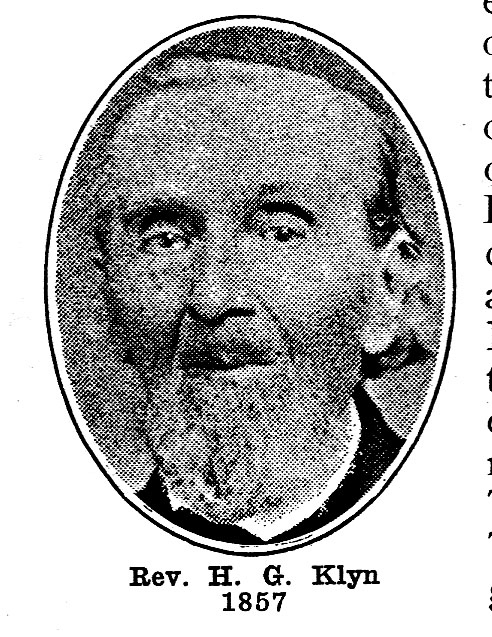
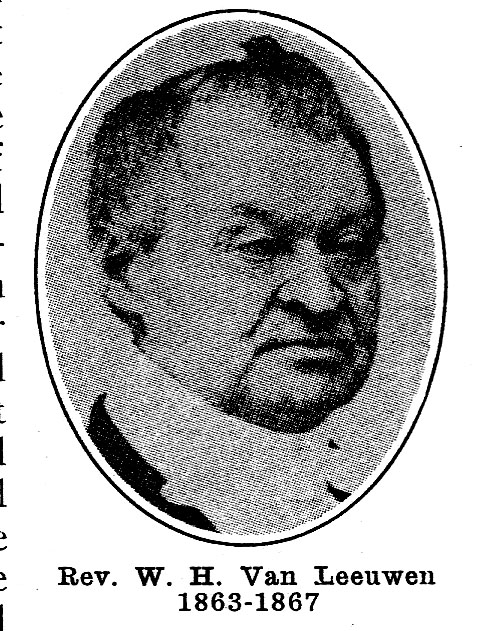
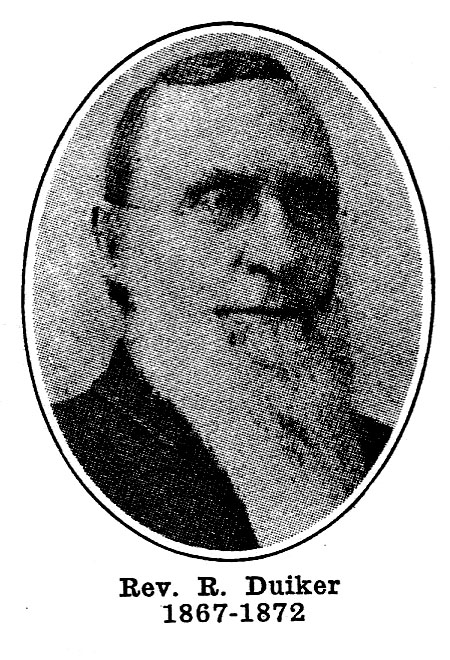
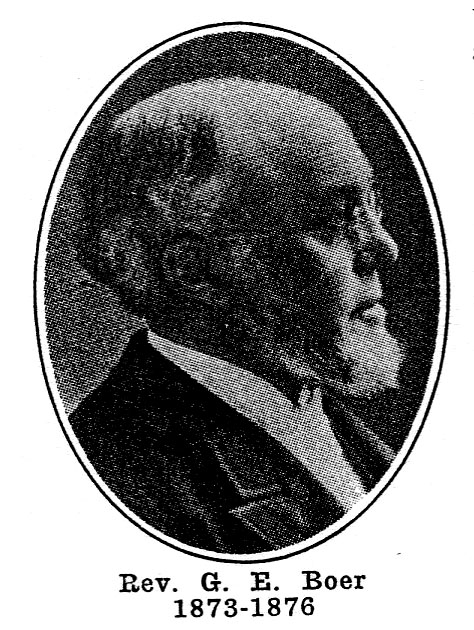
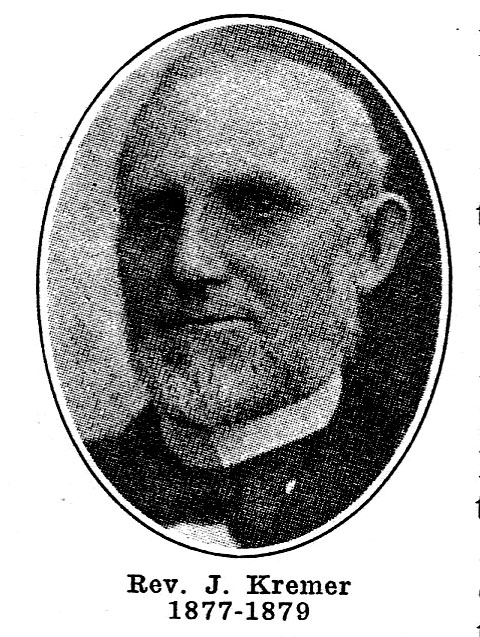
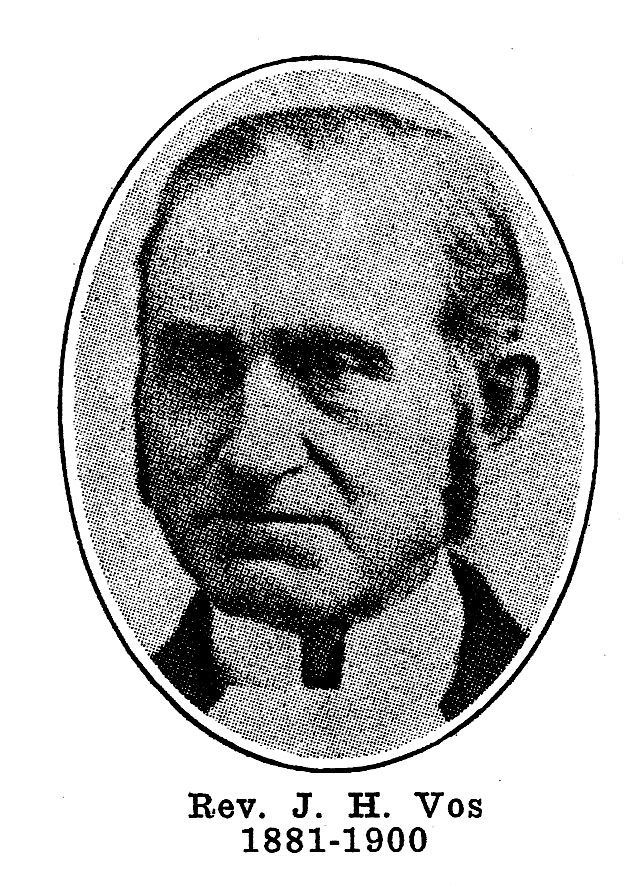
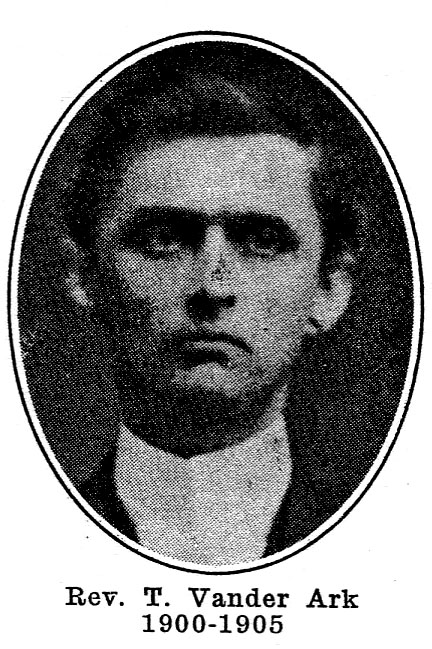
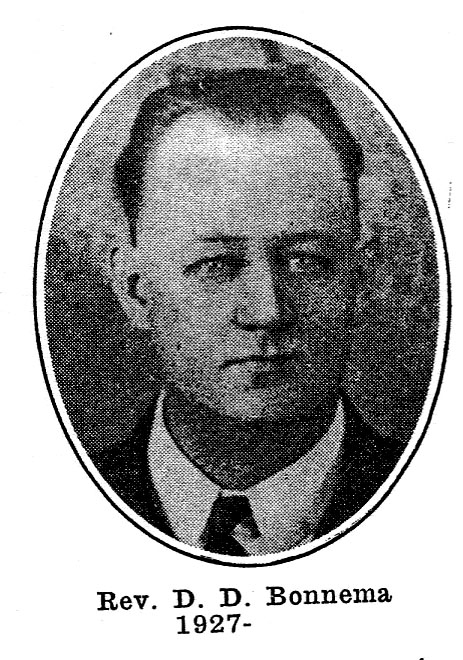
First Christian Reformed Pastors, 1857 - 1932
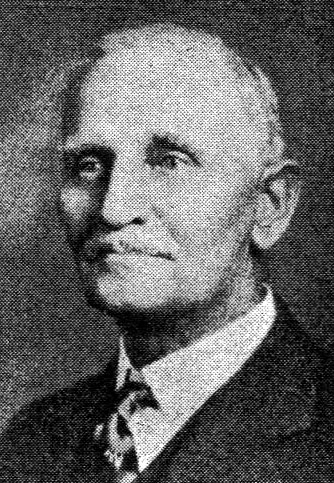
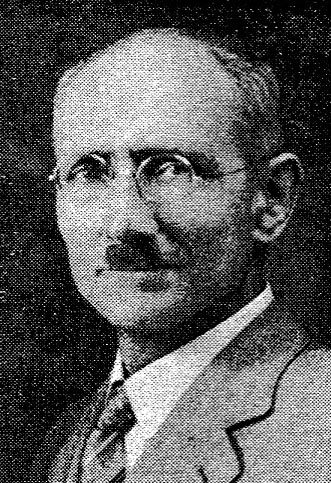
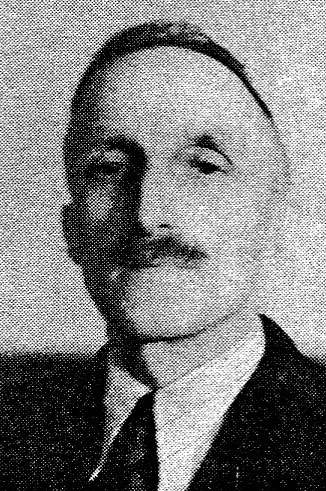
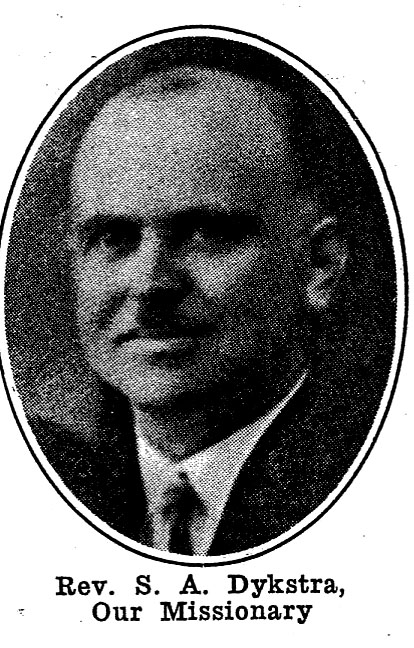
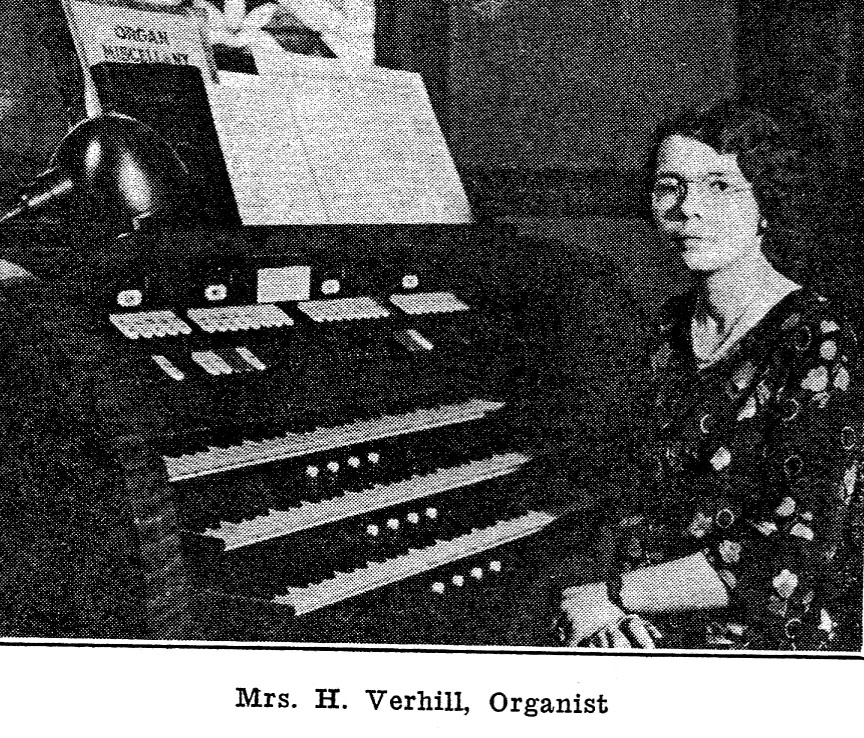
Left to right: Mr. J. Zaagman, who has
served our church longer as elder and deacon than any other present member.
Mr. G. Winsemius, who was our organist from 1887 to 1914.
Mr. W. Niemeyer, Janitor
Rev. S. A. Dykstra, Missionary in 1932
Mrs. H. Verhill, Organist in 1932
Transcriber: Angela Nyburg
Scanned by: ES
Created: 19 September 2012